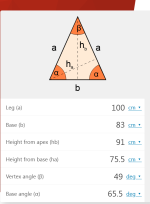• Umlautica - Hear Hear!
"I've been using DSP for more than 10 years now and here's what I've learned.
TL;DR: placement > treatment > room correction
Conceptualize is the schroeder frequency of your room. The schroeder frequency is where modal effects determine the steady state response at the listening position. Think of it as the crossover point between (a) the frequencies where the room modal effects dictate response and (b) frequencies where the direct response of the loudspeaker. It's typically 200-400Hz. This image helps explain.
Consider DSP strategy as two logical categories:
Loudspeaker correction: the nearfield, quasi-acoustic, direct magnitude response of the speaker.
Room correction: primarily the frequencies below the Schroeder frequency of the room. It also will correct the room power as well.
The room power response is different from the magnitude response of the system. The room power is what happens when flat on-axis loudspeakers bounces bounce sound around and have it absorbed by the room. This is what Harman found in steady state measurements.
There's a saying that "you mostly hear the room". This usually omits that it mostly applies below the schroeder frequency. Above this frequency, the principal determiner of sound quality is the direct loudspeaker response. Below it, the room takes over.
DSP is a great tool to have, it's not a panacea. Tools can be misused.
For example, if your speakers have poor directivity (off-axis response), DSP cannot fix it. You can dump gain on a null and do nothing but add distortion and eat headroom. DSP cannot fix the null but it can help by taking some energy out of a peak from a room mode.
Some generalizations of what to expect for correcting above the schroeder frequency:
Bad on-axis: easy DSP gains - fire and forget
Good on-axis with decent directivity: non-trivial DSP gains - use caution
Great on-axis with good directives: difficult to improve with DSP - can't fix what isn't broken
So if someone has JBL M2 towers, it's usually unreasonable to assume that full-range correction will improve things. It can do more harm than good. The M2 ship with an amplifier preloaded with DSP filters that provide a flat on-axis response.
My ideal order of operations:
Place subwoofer/speakers where room mode issues are minimized at the main listening position. For subwoofers, try the "sub crawl". Try midpoints of the front and rear wall. Try nearfield subwoofer placement. Try corners. Try everything until you're ready to find a new hobby. If you have a rectangular room, the REW Room Sim can offer tips.
Set up your room treatment. To make a long topic short; first reflection points within ~5ms of path length, wideband treatment behind to reduce SBIR, and dispersion on the back wall.
Use DSP to time align each subwoofer with your main speakers. The REW Spectrogram is a fantastic tool for this task.
Set subwoofer gain to be a few dB above your main speakers.
Experiment with the main/sub crossover point. If you have a room mode below 80Hz, it may help to center the room mode at the crossover point.
Find what you prefer for toe-in of your main speakers. This depends on your speakers and boundary reflections. Get a friend to help. If you don't have any friends, try moving your head forward or back at your listening position to inform your next adjustment.
Measure your loudspeakers using gated near-field measurements to find the direct response at the acoustic center of the loudspeaker.
Use low-q filters to correct your loudspeakers to a flat response. Perfection is not the goal. Don't fuss with narrow dips. Save corrections below ~250Hz for room correction.
Now you're ready for room correction!
Run your favorite tool; DIRAC, Audessey, REW, GLM, etc. Be sure to take multiple measurements from multiple points to get an averaged spatial response. Correcting for one point in space almost guarantees that you'll make corrections that are worse for the space around that point.
Be careful trying to extend your bass response below the natural response of your subwoofer. It can take more excursion or power than the subwoofer can provide.
You may find that your room correction software performs best when low passed a little above the schroeder frequency of your room. Calibration can be limited to frequencies such as 20Hz-1000Hz like this. You also may find that a good target response follows the measured room response of the top octaves of your speakers.
You may find that room correction sounds thin. Many prefer a 3-6dB bump around 50-60Hz helps fix this.
Have fun with it. Try things. Have reasonable expectations."

